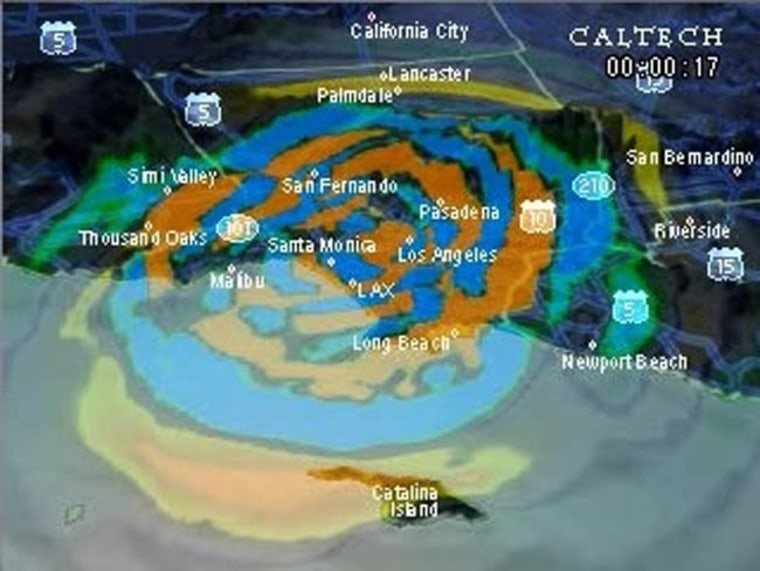Only in California will you soon be able to experience a life-threatening earthquake and watch a locally made, supercomputer-generated, 3-D movie of that shaking ground within 30 minutes of the first jolt.
A digital chain reaction is now in place, on purpose, so that scientists at Caltech and the San Diego Supercomputer Center can use data from a network of ground sensors and supercomputers to turn an earthquake into a near real-time animated movie that the public can watch on home computers or on TV as soon as the news breaks.
In fact, Caltech and the SDSC will make the first movie of this kind available to the media and public information providers the next time a magnitude-3.5 or greater earthquake strikes Southern California — which could be any day now.
How it's done
When an earthquake rattles Southern California, seismic recorders scattered at hundreds of stations across the earthquake-prone region constantly measure ground motion, providing seismologists with information to determine the temblor's epicenter, depth and intensity, explained Jeroen Tromp, a computational seismologist of Caltech who works with SDSC to make the movies.
Caltech scientists collect the data. For earthquakes with a magnitude of 3.5 or greater — which typically strike once or twice a month — the information is fed into a SDSC supercomputer called OnDemand. Rather than waiting several hours or days for results, a sophisticated computer model can produce a simulation of the ground motion in the area within about 28 minutes.
The OnDemand is a Dell cluster run by open-source Linux operation software and made up of 256 processors. It has a theoretical peak performance of 2.4 teraflops (a teraflop is a trillion floating point operations per second, and floating-point is an encoding system that makes it easy to work with extremely long numbers).
OnDemand is funded by the National Science Foundation.
E-mailed quake movies
In addition to the seismic data, the computer simulation relies on archived information about the subsurface structure of the region, which largely controls how the seismic waves will ripple out from the earthquake's epicenter.
For instance, when seismic waves pass through soft sediments, they slow down and the waves amplify (residents of low-lying regions near San Francisco Bay learned all about this in the 1989 Loma Prieta earthquake). Waves speed up when passing through hard rocks.
These 3-D animations are digitally overlaid onto the topography of Southern California and rendered into animated movies, which will be sent as an e-mail to public and news media subscribers.
“We’re getting good performance that will let us cut the time to deliver earthquake movies from about 45 to 30 minutes or less, and every minute is important," Tromp said. Detailed information about earthquake strikes assists in the delivery of emergency services to victims.
'Big one' movie
Another group of seismologists and computer scientists has generated simulations, or movies, of future California quakes, including the predicted "big one" that keeps some people awake at night in fearful anticipation.
Scientists at the Southern California Earthquake Center in Los Angeles are using these "virtual earthquakes," also generated by SDSC supercomputers, to learn more about how these most intense of ground shakers work.
One project called the TeraShake shows the trembling that would result if a 143-mile (230-kilometer) length of the San Andreas Fault ruptured to produce a magnitude-7.7 earthquake.
